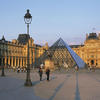More about Women of Algiers in Their Apartment
- All
- Info
- Shop

Sr. Contributor
In Femmes D’Alger Dans Leur Appartement, aka Women of Algiers, Eugène Delacroix depicts a harem with about the same historical accuracy as Disney's "Aladdin."
Completed after his visit to North Africa in 1832, the painting was regarded as an “authentic” representation of his eyewitness account. The trip was a diplomatic mission after the French invasion of Algeria in 1830, and the indigenous population were already under French rule. Delacroix was selected for the trip due to his history paintings of the Orient, including The Massacre of Chios and Death of Sardanapalus. Though the finished painting was completed from memory, Delacroix was able, due to the sway of his French superior, to visit the harem of an Algerian civil servant in order to sketch the women, which would not have been possible without colonial presence.
The harem, derived from the Arabic word “haram,” meaning forbidden or sacred, was a space reserved for female members of the household. By presenting the normally off-limits world, Delacroix created a new approach to painting women of the Orient which differed from the nude odalisques, exemplified by Jean-Auguste-Dominique Ingres' Grande Odalisque. These women are shown fully clothed, even overdressed to the point that their bodies sink to the ground. They are preoccupied, unconcerned by the gaze of the viewer. Though still voyeuristic, Delacroix’s women function as propaganda for France’s imperialist ambitions, rather than idealized figures for erotic viewing pleasure.
Delacroix’s de-eroticized, matter-of-fact style presents the image as objective, and thus confirms the Western view of the Orient. The scene is set in a dimly lit, richly decorated interior completed in painstaking detail. It contains the typical elements of European depictions of the harem - objects like hookah and glass vases, patterns associated with the Oriental style, and a black slave drawing the curtain. The scene suggests a sluggishness associated with the prevalent “lazy native” stereotype. Their sedentary poses also suggest a deference which legitimizes French colonial rule as a natural reflection of male superiority through the masculine colonizer and the feminine colonial subject.
Delacroix was fascinated with the East, and his trip reconfirmed his mystical view. Upon entering the harem, he allegedly exclaimed, “C’est beau! C’est comme au temps d’Homere!” (“It’s beautiful! It’s like the time of Homer!”). The East was seen as an unchanged place, and its depictions in art were drawn from antique Greek and Roman sculptures. The sources of inspiration for depicting the East present its inhabitants as “primitive” against the inherently superior, further developed Western civilization. The harem was also seen as a symbol of oppression by Europeans, who used their moral standard as a justification for their political and military domination. Thus, Women of Algiers, and other Orientalist works seeking to depict an “objective” image of the Orient for a Western audience, are more about the self-identification of the West against an Eastern “other” through artificially constructed “realities,” rather than an effort to sincerely portray a different culture.
The painting has had a lasting impact on art, reinforcing Romantic stereotypes of the East and notably inspiring Pablo Picasso’s painting of the same title, which sold for a record-breaking $175 million.
Sources
- Cascone, Sarah. “The MFA Houston Just Bought a Long-Lost Delacroix Painting That Popped Up in a Paris Apartment.” ArtNet. September 26, 2019. https://news.artnet.com/art-world/museum-fine-arts-houston-delacroix-16….
- Hiddleston, J. A. "Baudelaire, Delacroix, and Religious Painting." The Modern Language Review 92, no. 4 (1997): 864-76. Accessed June 21, 2021. doi:10.2307/3734206.
- Ma, Laurel. “The Real and Imaginary Harem: Assessing Delacroix’s Women of Algiers as an Imperialist Apparatus.” Penn History Review Volume 19, Issue 1 ( 2011): 9-26.
- Mortimer, Mildred. "Edward Said and Assia Djebar: A Contrapuntal Reading." Research in African Literatures 36, no. 3 (2005): 53-67. Accessed June 21, 2021. http://www.jstor.org/stable/3821363.
- Vogl, Mary B. "Using the Arts to Teach Assia Djebar's "Femmes D'Alger Dans Leur Appartement"." The French Review 76, no. 4 (2003): 692-720. Accessed June 21, 2021. http://www.jstor.org/stable/3133081.
Featured Content
Here is what Wikipedia says about Women of Algiers



Women of Algiers in their Apartment (French: Femmes d'Alger dans leur appartement) is the title of two oil on canvas paintings by the French Romantic painter Eugène Delacroix.
Delacroix's first version of Women of Algiers was painted in Paris in 1834 and is located in the Louvre, Paris, France. The second work, painted fifteen years later between 1847 and 1849, is located at the Musee Fabre, Montpellier, France. The two works both depict the same scene of four women together in an enclosed room. Despite the similar setting, the two paintings evoke completely different moods through the depiction of the women. Delacroix's earlier 1834 work captures the separation between the women and the viewer. The second painting instead invites the viewer into the scene through the warm inviting gaze of the women.
Women of Algiers, along with Delacroix's other Orientalist paintings, has inspired many artists of later generations. In 1888 both Vincent van Gogh and Paul Gauguin travelled to Montpellier to view Delacroix's 1849 version of Women of Algiers. The painting served as a source of inspiration to the later impressionists, and a series of 15 paintings and numerous drawings by Pablo Picasso in 1954.
Paul Cézanne described Delacroix's intoxicating colour plays as "All this luminous colour... It seems to me that it enters the eye like a glass of wine running into your gullet and it makes you drunk straight away".
Check out the full Wikipedia article about Women of Algiers













